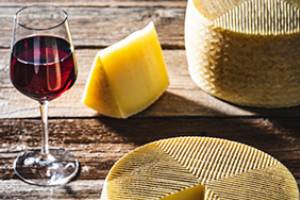|
While there isn’t a specific “National Ham and Eggs Day,” March 26th is Make Up Your Own Holiday Day. To celebrate, we present a recipe for a savory, fun, and totally delicious combination of ham and eggs on a waffle.
The egg yolk drizzles down over the waffle, and you can even add a drop of maple syrup (or hot sauce, if you prefer).
You can add steamed or roasted vegetables as you wish: asparagus, bell peppers, mushrooms, zucchini, even blistered cherry tomatoes.
Waffles are comfort food, and these can be eaten all day long: breakfast, lunch, and dinner.
If you don’t have a waffle iron, you can make pancakes or adapt* the recipe to French toast.
We adapted this recipe from one by Leslie Ponce of Miami, Florida, featured in Taste of Home.
We simplified it, which included using your own favorite waffle recipe or mix instead of mixing from scratch.
We used our favorite whole grain, high protein pancake and waffle mix, Long Table. We are fans of both popcorn mix (popcorn flour, oat flour, almond meal and a hint of poppyseed) and the Blue Corn (heirloom organic blue corn, heirloom organic rye, heirloom organic buckwheat, and non-GMO hazelnut meal).
A bonus for people who avoid gluten: The mix is gluten-free! But gluten or not, it has such great flavor and nutrition that we give boxes as gifts. Here’s our review.
> The year’s 11 ham holidays are below.
> So is the difference between Emmental and Gruyère Swiss cheeses, the French version Comté, and American Swiss-style cheese.
> Egg holidays.
> Breakfast holidays.
> The history of waffles.
> The history of chicken and waffles.
> More savory waffle recipes.
RECIPE: WAFFLES WITH HAM, EGGS, & CHEESE
You can use cubed ham, as was done in the original recipe, or sliced ham. The benefit of the cubes is that you don’t need a knife…but that’s small potatoes (or small ham cubes, as you prefer).
The original recipe used roasted vegetables, which required the oven, and a from-scratch waffle recipe.
We first sliced our asparagus and steam them. Cook them as you wish, or eliminate the vegetables entirely.
In fact, the second time we made this recipe, we used a jar of pimento (roasted red pepper strips—photo #9) and defrosted green peas (photo #10) for splashes of color.
Ingredients For 6 Servings
1 bunch scallions, finely chopped, or minced chives
16 fresh asparagus spears (photo #8), cut into 1/4-inch pieces and steamed lightly
3/4 teaspoon salt, divided
1/4 teaspoon pepper
6 large eggs, room temperature, divided
2 cups all-purpose flour
1/4 teaspoon cayenne pepper (photo #11)
1-1/2 cups 2% milk
6 tablespoons butter, melted
1 cup shredded Gruyère cheese, divided (substitute Swiss)
1 fully cooked boneless ham steak (12 ounces), cubed, or sliced ham
Optional garnish: minced chives or parsley
Preparation
1. PREHEAT a greased waffle iron. Prepare the waffle batter and add the asparagus, scallions, and cayenne pepper.
2. BAKE† the waffles according to manufacturer’s directions until golden brown. Keep warm in a covered dish while you cook the others. Meanwhile…
2. COAT a large skillet with cooking spray. Cook the ham until heated through; keep warm in a covered dish. In same skillet…
3. FRY the eggs until the yolks are set.
4. SERVE: Top each waffle with 1 egg. Sprinkle ham cubes the remaining 1/4 cup cheese. Garnish with minced herbs.
THE DIFFERENT TYPES OF SWISS CHEESE
There are 450 known Swiss cheeses, classified into five categories: extra-hard, hard, semi-hard, semi-soft and soft. Cow’s milk is used in 99% of the cheeses produced. Examples include:
Extra-Hard Swiss Cheese: Sbrinz
Hard Swiss Cheese: Emmentaler, Gruyère/Greyerzer, Sapsago and Vacherin Fribourgeois
Semi-Hard Swiss Cheese: Appenzeller, Bündner Bergkäse, Mutschli, Raclette cheese, Tête de Moine, Tilsiter
Semi-Soft Swiss Cheese: Vacherin Mont d’Or
Soft Swiss Cheese: Gala
Here’s more about them.
The recipe calls for Gruyère, but you can substitute Emmental, another Swiss mountain cheese, or two French cheeses: Comté, France’s approximation of Gruyère, or Emmental de Savoie, its approximation of Swiss Emmentaler.
All four are part of the broader category of Alpine-style cheeses, also called mountain cheeses, which are made in mountainous regions, often using milk from cows that graze in alpine pastures.
All four hold protected status: Gruyere, Emmental, and Comté have A.O.P. (Appellation d’Origine Protégée) status and I.G.P (Indication Géographique Protégée)
What’s the difference?
EMMENTALER CHEESE VS. GRUYÈRE
Emmenthaler is the German spelling for the cheese and is commonly used in Switzerland as well. It means “from the Emme Valley.”
The valley is in the Swiss canton of Bern, known for its rolling hills and the Emme River that runs through them. It is a big dairy farming region.
Although Switzerland is the birthplace of Emmentaler cheese, other countries, including Germany, France, and Austria, produce their own Emmental-style cheeses.
However, Emmentaler AOP (Appellation d’Origine Protégée) is a protected name and signifies that the cheese is made in certain areas, following traditional methods.
It can only be made in the canton of Bern and some surrounding areas in central and western Switzerland.
However, cheeses called simply “Emmental” in France and other countries (like Germany, Austria, and the U.S.) do not have protected status.
In many parts of the world, “Emmental” is used as a generic name for any large-holed cheeses, often produced on an industrial scale, which may not follow traditional methods.
In the U.S., the generic cheese called “Swiss” is actually an attempt to emulate the great Swiss cheese, Emmenthal. If you want to save money and use “shredded Swiss” instead of buying Emmental or Gruyère, the choice is yours.
Gruyère & Emmentaler Differences;
Both are hearty, firm Swiss mountain cheeses but have some key differences:
Flavor: Gruyère is rich, nutty, and slightly sweet with a deeper, more complex taste as it ages. Emmentaler is milder, buttery, and slightly sweet with a less pronounced nuttiness.
Texture: Gruyère is dense and smooth, becoming firmer with age. Emmentaler is more elastic and slightly softer, with a springy texture.
Eyes (Holes): Gruyère typically has few or no holes. Emmental has large, round holes.
Aging: Gruyère is aged 5–12 months or longer, developing deeper flavors as it ages. Emmentaler is typically aged 4–8 months, resulting in a milder flavor.
Best Uses: Gruyère is the popular melting cheese for fondue, French onion soup, gratins, grilled cheese, and quiche. Emmentaler is also used to make classic Swiss fondue and quiche, and also in sandwiches (Croque Monsieur, e.g.) and on cold cut trays.
If you’re substituting one for the other, Gruyère provides a more intense flavor, while Emmentaler is milder and slightly sweeter.
THE DIFFERENCE BETWEEN TRUE GRUYÈRE FROM SWITZERLAND & COMTÉ FROM FRANCE
Comté is also a mountain cheese, but from the Jura Mountains, sub-alpine mountain range in the Bourgogne-Franche-Comté region of France, which north of the Alps along the Swiss-French border.
It has a similar flavor profile to Gruyère but because of differences in milk and production:
Comté tends to have a more varied flavor.
Gruyère is firmer, denser, and more elastic texture. Comté is more supple and slightly softer.
Comté has a more open texture with tiny, irregular holes. Gruyère has fewer, if any holes.
Gruyère is typically aged 5 to 12 months, producing flavors that are nutty, slightly sweet, and creamy, with a more pronounced saltiness than Comté. Longer-aged (up to 24 months) Gruyère Réserve develops more complex flavors, including caramelized and earthy notes. Comté, aged 4 to 36 months, is milder and more buttery when young but develops deep, layered flavors as it ages, ranging from roasted nuts and butter to caramel, fruit, and even umami.
WHAT ABOUT FRENCH EMMENTAL DE SAVOIE?
France produces a cheese called Emmental de Savoie IGP (Indication Géographique Protégée), produced in the Savoie and Haute-Savoie regions of France. It is protected, must come from a designated region, but I.G.P. has slightly less strict regulations than A.O.P. status.
|
|

[1] The recipe: savory waffles with ham and a fried egg (photo © Taste Of Home).

[2] Our favorite pancake mix (photos #2 and #3 © Longtable).
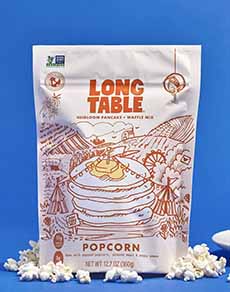
[3] The Popcorn mix is made with flour from popped corn that is then ground.
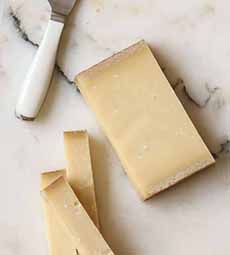
[4] Gruyère is a mountain cheese made in Switzerland from raw cow’s milk (photo © Murray’s Cheese).
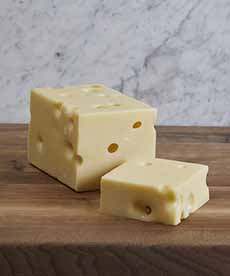
[5] Emmental is another raw milk mountain cheese from Switzerland. See how it differs from Gruyère below (photo © De Laurenti).
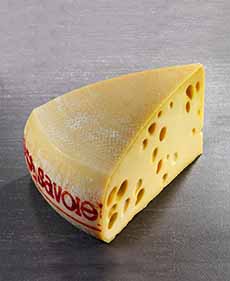
[6] Emmental de Savoie, the French version of Emmental. See how it differs from Swiss Emmental below4 (photo © Fromagerie de Chambéry).
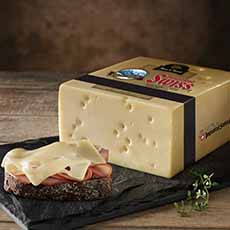
[7] American Swiss cheese is quite different from Emmental and Gruyère. See why below (photo © Boar’s Head).

[8] Spring is prime asparagus season (photo © Good Eggs).
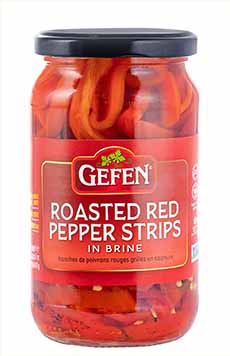
[9] Roasted red pepper strips, a.k.a. pimento or pimiento (photo © Gefen | Amazon).
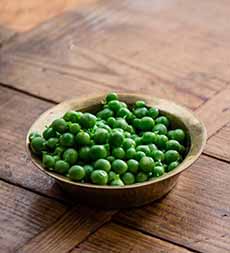
[10] (photo © Maude Restaurant | Los Angeles).
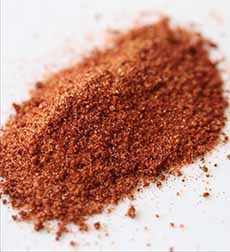
[11] Cayenne refers to both a type of hot chile and the powdered spice made from dried and ground cayenne chiles (photo © McCormick).
|
Emmental de Savoie (France) vs. Swiss Emmental
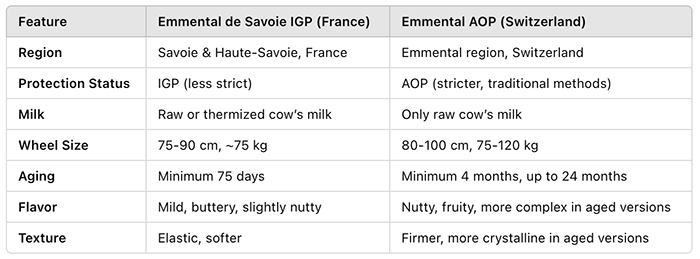
[12] Thanks to ChatGPT for this concise chart.
To compare the cheeses in photos: Swiss Emmental is photo #5 and Emmental de Savoie is photo #6. You can see how large the eyes are!
Comté vs. Emmental de Savoie
Both cheeses are made from raw cow’s milk, but Comté must be made only from Montbéliarde and Simmental cows, while Emmental de Savoie can use milk from different breeds.
Comté is made in smaller, traditional dairies called fruitières in smaller wheels (about 55-75 cm in diameter, weighing up to 45 kg), and aged for a minimum of 4 months, but often 12 to 36 months, leading to a much more complex flavor. Emmental de Savoie is made in larger wheels (about 75-90 cm in diameter, weighing up to 75 kg), often in slightly more industrialized processes. It’s aged for a minimum 75 days, It develops large eyes during aging.
Back to flavor and texture: Comté is firmer, yet still creamy, with aging adding depth and small crunchy crystals (tyrosines). It has more complex and nuanced flavors—nutty, caramelized, with hints of fruit, butter, and umami. Emmental de Savoie has a more elastic and supple texture, is mild, buttery, slightly nutty, plus sweeter, with subtle fruity notes.
THE DIFFERENCE BETWEEN AMERICAN SWISS CHEESE & REAL SWISS FROM SWITZERLAND
American Swiss cheese (photo #7)is quite different from Emmental and Gruyère. It’s less expensive, so even people who might prefer authentic Swiss cheeses will buy it.
Flavor: American Swiss is milder in flavor with less complexity.
Texture: American Swiss is smoother and more processed. It melts well but lacks the elasticity‡ of traditional Swiss cheeses.
Production & Aging: American Swiss is aged for a short time, often just weeks, usually made with pasteurized milk, and sometimes contain additives to control hole size. Authentic Swiss cheeses are made from raw milk and have no additives. Emmental is aged 4–18 months, made from raw cow’s milk; Gruyère is aged 5–12+ months.
Eyes (Holes): American Swiss has smaller and more uniform holes (often controlled for appearance and slicing); authentic Swiss cheeses allow the eyes to form naturally during fermentation.
ChatGPT and Claude.ai were used for most of the cheese comparison information above, between 2025-03-20 and 2025-03-26.
THE YEAR’S 11 HAM HOLIDAYS
In addition to our unofficially declared National Ham & Eggs Day, we celebrate ham on:
March 3: National Cold Cuts Day
April 4: National Chicken Cordon Bleu Day
National Baked Ham with Pineapple Day is observed next on Sunday, April 20th, 2025. It is observed the first Sunday after the full moon following the March Equinox.
April 15: National Glazed Spiral Ham Day
April 16: National Eggs Benedict Day
May 20: National Quiche Lorraine Day
August 23: National Cuban Sandwich Day
September 17: National Monte Cristo Sandwich Day
October: Eat Country Ham Month
November: National Roasting Month
December 18: National Ham Salad Day
and
March 1: National Pig Day
________________
*For French Toast, you can stir finely minced chives into the batter or omit them; and lay the asparagus atop the toast and under the egg.
†Waffles are considered “baked” because the plates of the waffle iron generate dry heat, similar to baking in an oven.
‡The elasticity of cheese refers to how stretchy and flexible the cheese is when cut, pressed, or melted. It’s a measure of how well the cheese can bend or spring back without breaking. The more elastic the cheese, the easier it melts.
CHECK OUT WHAT’S HAPPENING ON OUR HOME PAGE, THENIBBLE.COM.
|












